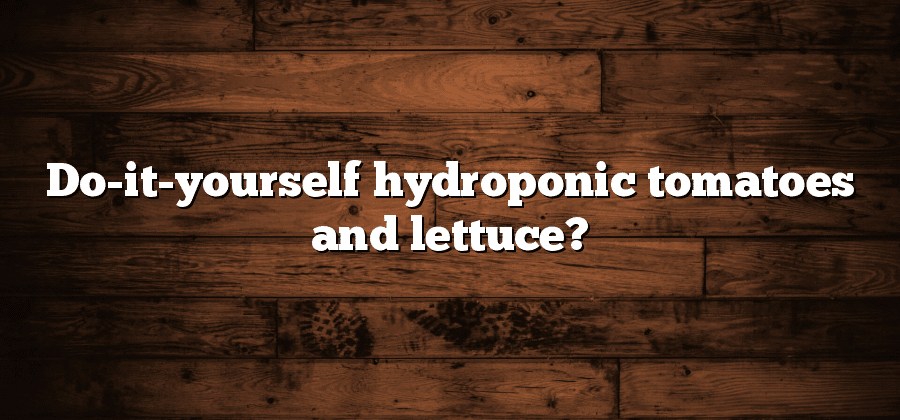Benefits of Growing Hydroponic Tomatoes and Lettuce
Hydroponic gardening offers a range of benefits for individuals looking to grow their own tomatoes and lettuce. One of the main advantages is the ability to control the growing conditions, resulting in higher yields and improved quality of produce. By providing the ideal balance of nutrients, water, and light, hydroponic systems promote healthy plant growth, leading to bigger and tastier tomatoes and lettuce.
Furthermore, hydroponic gardening is space-efficient, making it suitable for individuals with limited outdoor space. Traditional soil-based gardening requires large plots of land, but hydroponics allows for vertical farming or setting up systems in small areas, such as balconies or indoor spaces. This flexibility not only saves space but also opens up opportunities for urban gardening and year-round growing. In addition, hydroponic systems tend to use less water compared to conventional gardening methods, addressing environmental concerns and conserving a precious resource.
Setting Up Your Hydroponic System at Home
To successfully set up your hydroponic system at home, there are a few key steps to follow. Firstly, you will need to choose the appropriate system for your space and needs. There are various types of hydroponic systems available, such as nutrient film technique (NFT), deep water culture (DWC), and aeroponics. Each system has its advantages and limitations, so it’s essential to research and select the one that suits your requirements.
Once you have chosen a hydroponic system, the next step is to create an ideal environment for your plants. You will need to consider factors such as temperature, humidity, and lighting. Most hydroponic systems require a grow light setup to provide sufficient artificial lighting for your plants. Additionally, maintaining a stable temperature and humidity level is crucial for the optimal growth of your hydroponic crops. By ensuring the right conditions, you can maximize the yield and quality of your hydroponic tomatoes and lettuce.
Selecting the Right Tomato and Lettuce Varieties for Hydroponics
When it comes to selecting the right tomato and lettuce varieties for hydroponics, there are several factors to consider. First and foremost is the growth habit of the plant. Determinate varieties are a popular choice for hydroponics as they tend to grow well in confined spaces and produce a high yield of fruit. Indeterminate varieties, on the other hand, may require more space and support as they have a vining habit and can grow quite tall.
Another factor to consider is the time to maturity. In hydroponics, where the growing conditions are carefully controlled, it is important to select varieties that have a relatively short maturation period. This ensures a continuous harvest and maximizes the use of the growing space. Additionally, disease resistance is an important characteristic to consider. Certain tomato and lettuce varieties have been bred to be resistant to common diseases, such as fusarium wilt and powdery mildew, which can be especially beneficial in a hydroponic system where plants are grown in close proximity.
Choosing the Ideal Location for Your Hydroponic Garden
When it comes to setting up your hydroponic garden, choosing the ideal location is one of the most critical factors for success. The right location can greatly impact the growth and productivity of your hydroponic tomatoes and lettuce.
To begin, it is important to find a space that receives ample sunlight throughout the day. Ideally, your hydroponic garden should be placed in an area that gets at least six to eight hours of direct sunlight. This will ensure that your plants receive the necessary light energy for photosynthesis, which is essential for their growth and development. Additionally, avoid areas that are prone to strong winds or drafts as they can damage the delicate structure of your plants.
Another aspect to consider is the accessibility of your hydroponic garden. Make sure to select a location that is easily accessible for maintenance tasks such as watering, monitoring nutrient levels, and harvesting. This will save you time and effort in the long run and ensure that you can properly care for your hydroponic plants.
Furthermore, the location should provide a stable environment for your garden. Avoid areas that experience extreme temperature fluctuations or are prone to flooding. Consistency in temperature and humidity levels will create an optimal growing environment for your hydroponic tomatoes and lettuce.
In conclusion, choosing the ideal location for your hydroponic garden is crucial for the successful growth and productivity of your plants. Ensure that the location receives enough sunlight, protects your plants from strong winds, is easily accessible, and provides a stable environment. By taking these factors into consideration, you will be well on your way to creating a thriving hydroponic garden at home.
Understanding the Nutrient Requirements for Hydroponic Tomatoes and Lettuce
When it comes to growing hydroponic tomatoes and lettuce, understanding the nutrient requirements is crucial for achieving healthy and thriving plants. Unlike traditional soil-based gardening, hydroponics relies on a nutrient-rich solution to provide everything the plants need to grow. By providing the right balance of nutrients, you can ensure optimal growth, yield, and flavor in your hydroponic tomatoes and lettuce.
Tomatoes and lettuce have different nutrient requirements, so it’s important to tailor your nutrient solution accordingly. For tomatoes, they require higher amounts of macronutrients such as nitrogen, phosphorus, and potassium. These nutrients are essential for promoting vigorous growth, setting flowers, and developing fruits. Additionally, tomatoes benefit from essential micronutrients like calcium, magnesium, iron, and zinc, which aid in overall plant health and disease resistance. On the other hand, lettuce requires slightly lower levels of macronutrients than tomatoes. However, they have higher requirements for certain micronutrients like manganese and boron, which play a crucial role in leaf development and coloration. By understanding these specific nutrient needs, you can provide your hydroponic tomatoes and lettuce with the optimal nutrition for robust growth and bountiful harvests.






